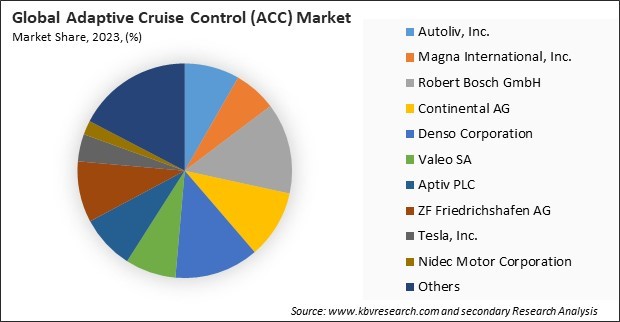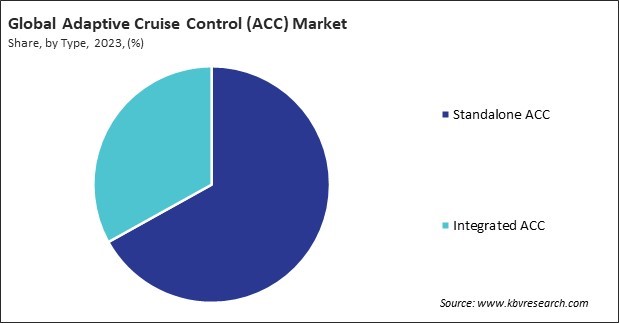“Global Adaptive Cruise Control (ACC) Market to reach a market value of 53.3 Billion by 2031 growing at a CAGR of 17%”
The Global Adaptive Cruise Control (ACC) Market size is expected to reach $53.3 billion by 2031, rising at a market growth of 17.0% CAGR during the forecast period.
In 2023, the Asia Pacific region generated 45% revenue share in the ACC market. This dominance can be attributed to the rapid growth of the automotive industry in countries like China, Japan, and India, where there is a strong demand for advanced driver assistance systems. The increasing adoption of electric vehicles and the rising awareness of vehicle safety features have further fueled the growth of the ACC market in this region.

Consumers are increasingly aware of the importance of road safety, driven by rising statistics on road accidents and fatalities. Organizations such as the World Health Organization (WHO) and various national traffic safety authorities regularly publish data highlighting the need for improved vehicle safety systems, raising public consciousness about the benefits of advanced driver assistance systems (ADAS) like ACC. Thus, growing consumer demand for enhanced vehicle safety features drives the market's growth.
Additionally, Governments worldwide are increasingly implementing regulations that require vehicles to be equipped with advanced safety systems to reduce road accidents and enhance overall safety. For instance, the EU's General Safety Regulation mandates that all new cars sold in the EU must be equipped with advanced safety features, including ACC, from 2022 onwards. Therefore, stringent government regulations and safety standards propel the market's growth.
However, ACC systems use advanced sensors, cameras, radar, and lidar technologies to function effectively. These components, particularly radar and lidar systems, can be costly to manufacture and integrate into vehicles. Additionally, the software that processes the data from these sensors to maintain safe distances and adjust speed is complex and requires continuous development and refinement. In conclusion, the high cost of adaptive cruise control systems is hampering the market's growth.

The leading players in the market are competing with diverse innovative offerings to remain competitive in the market. The above illustration shows the percentage of revenue shared by some of the leading companies in the market. The leading players of the market are adopting various strategies in order to cater demand coming from the different industries. The key developmental strategies in the market are Acquisitions, and Partnerships & Collaborations.
Based on product sales, the adaptive cruise control (ACC) market is divided into OEMs (original equipment manufacturers) and aftermarket. The aftermarket segment attained 28% revenue share in this market in 2023. This segment caters to vehicle owners looking to retrofit their existing vehicles with ACC systems, driven to enhance safety and driving comfort in older models. Although it holds a smaller revenue share than the OEM segment, the aftermarket remains crucial, offering solutions for upgrading vehicles with the latest driver assistance technologies.
On the basis of type, the adaptive cruise control (ACC) market is segmented into standalone ACC and integrated ACC. In 2023, the integrated ACC segment attained 33% revenue share in this market. Integrated ACC systems are part of a comprehensive suite of ADAS, combining multiple functions such as lane-keeping assistance, automatic emergency braking, and traffic jam assist. This integration enhances the overall driving experience by offering higher automation and safety.

Based on component, the adaptive cruise control (ACC) market is categorized into radar sensors, LIDAR sensors, ultrasonic sensors, cameras, and others. The LIDAR sensors segment witnessed 23% revenue share in this market in 2023. LIDAR technology offers high-resolution and precise 3D mapping, making it valuable for ACC systems, especially in complex driving environments. Although more expensive than radar sensors, LIDAR technology's increasing advancements and decreasing costs drive its adoption in ACC systems, contributing to the segment's revenue share.
By vehicle type, the adaptive cruise control (ACC) market is divided into passenger car and commercial vehicle. The commercial vehicle segment procured 37% revenue share in this market in 2023. The need for improved safety and efficiency in long-haul and logistics operations primarily drives adopting ACC systems in commercial vehicles. Fleet operators and commercial vehicle manufacturers are increasingly integrating ACC technology to enhance driver comfort, reduce fatigue, and improve road safety.
Free Valuable Insights: Global Adaptive Cruise Control (ACC) Market size to reach USD 53.3 Billion by 2031
Region-wise, the adaptive cruise control (ACC) market is analyzed across North America, Europe, Asia Pacific, and LAMEA. The North America region witnessed 26% revenue share in this market in 2023. The region's robust automotive market, characterized by a high penetration of advanced vehicle safety features, has contributed to substantial revenue generation. The increasing focus on enhancing vehicle safety and comfort, along with stringent government regulations promoting the adoption of advanced driver assistance systems, has driven the growth of the ACC market in North America.
| Report Attribute | Details |
|---|---|
| Market size value in 2023 | USD 15.6 Billion |
| Market size forecast in 2031 | USD 53.3 Billion |
| Base Year | 2023 |
| Historical Period | 2020 to 2022 |
| Forecast Period | 2024 to 2031 |
| Revenue Growth Rate | CAGR of 17.0% from 2024 to 2031 |
| Number of Pages | 275 |
| Tables | 420 |
| Report coverage | Market Trends, Revenue Estimation and Forecast, Segmentation Analysis, Regional and Country Breakdown, Market Share Analysis, Porter’s 5 Forces Analysis, Company Profiling, Companies Strategic Developments, SWOT Analysis, Winning Imperatives |
| Segments covered | Product Sales, Type, Component, Vehicle Type, Region |
| Country scope |
|
| Companies Included | Autoliv, Inc., Magna International, Inc., Robert Bosch GmbH, Continental AG, Denso Corporation, Valeo SA, Aptiv PLC, ZF Friedrichshafen AG, Tesla, Inc., and Nidec Motor Corporation |
By Product Sales
By Type
By Component
By Vehicle Type
By Geography
The Market size is projected to reach USD 53.3 billion by 2031.
Growing Consumer Demand For Enhanced Vehicle Safety Features are driving the Market in coming years, however, High Cost Of Adaptive Cruise Control Systems restraints the growth of the Market.
Autoliv, Inc., Magna International, Inc., Robert Bosch GmbH, Continental AG, Denso Corporation, Valeo SA, Aptiv PLC, ZF Friedrichshafen AG, Tesla, Inc., and Nidec Motor Corporation
The expected CAGR of this Market is 17.0% from 2024 to 2031.
The Radar Sensors segment led the maximum revenue in the Market by Component in 2023, thereby, achieving a market value of $24.3 billion by 2031.
The Asia Pacific region dominated the Market by Region in 2023, and would continue to be a dominant market till 2031; thereby, achieving a market value of $24.8 billion by 2031.
Our team of dedicated experts can provide you with attractive expansion opportunities for your business.

 Drivers
Drivers
 Restraints
Restraints
 Opportunities
Opportunities
 Challenges
Challenges
